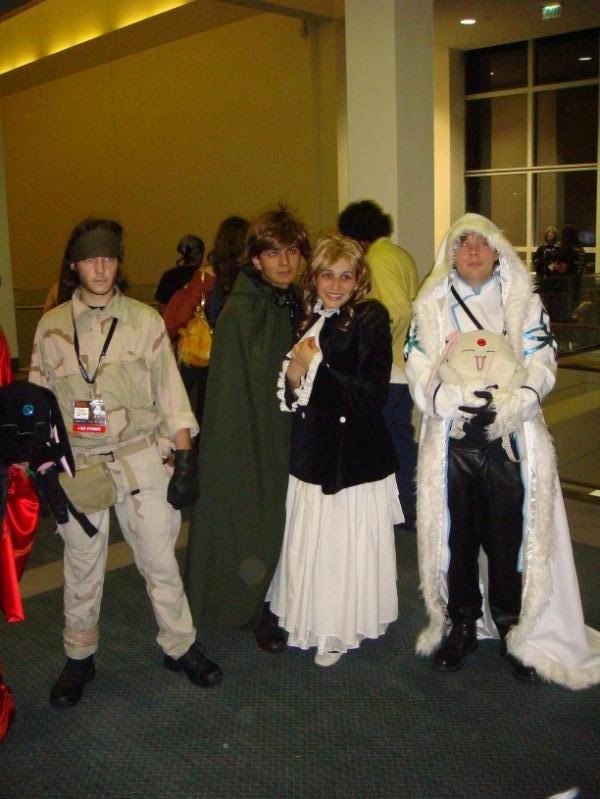The scattershot musings of a Los Angeles appellate attorney and devotee of popular culture
Tuesday, July 29, 2008
Some of That Rock 'n Roll Music
More about the convention soon, promise. (I'm still unpacking.) But just a note to let everyone know that the earthquake today was merely an amusement park ride -- although the blinds-rods and the plant in my office were swaying for quite a while.
Thursday, July 24, 2008
Comic-con 2008: Day Zero

The completely sold out Comic-Con International:San Diego (known affectionately just as Comic-Con) is in full swing. Last night, from 6 to 9 p.m., the Con held its preview night, in which those with four-day memberships are permitted first crack at the Dealer's Room. (Or, as they call it, the Exhibit Hall. "Is this the line to the Dealer's Room?" Amy asked one of the security guards. "This is the line to the Exhibit Hall," he corrected her.)
Despite the limit to four-day members, the Dealer's Ro -- er, Exhibit Hall was packed with attendees, with long lines for particular products (such as the new COMIC BOOK TATTOO book from Image, which features comics based on Tori Amos songs. Amos will be at the Con; and the Image booth sold out of the softcover editions of the book and was doing brisk business with the limited edition hardcover.)

The booths we saw (just a fraction of the total ones) were filled with wonders -- the most amazing of which was a full-sized Owl Ship from the WATCHMAN movie in the Warner Brothers booth. The interior was dressed with controls, LED readouts and straps that looked like vintage WWII bomber leftovers; and fans were enthusiastically photographing it inside and out.


Also astounding was the Sideshow Collectibles booth, which featured dazzling statues and busts of comics, movies, and video game characters.

We met up with friends Natalie, Sarah and Elizabeth, and stopped by Colleen Doran's table at the dealer's room, where we relieved her of a remarqued edition of the first volume of ABSOLUTE SANDMAN (featuring a gorgeous color sketch of the main character drawn onto the frontispiece) and she relieved us of some money.
Saturday, July 19, 2008
Joker's Wild
Yesterday we saw THE DARK KNIGHT; and apparently we weren't alone. Estimates peg the latest Bat-movie at pulling in around $155 million this weekend, making for the best opening weekend ever for a film, and posturing DARK KNIGHT to go head-to-head with IRON MAN for top movie of the summer. (I find appropriate that these two armored billionaires should grapple mano-a-mano for supremecy. It's the old Marvel vs. DC battles all over again.)
[some mild SPOILERS coming up . . . ]
The one aspect of the DARK KNIGHT I found weak was the bat-suit. In several sequences, especially near the beginning of the film, when it is shown in the light it merely looks silly. I do appreciate the redesign of the bat-armor worked into the movie -- "You'd like to be able to turn your head?" quips armourer Lucius Fox -- but at this point the best design might be the simple look of the comics suit. If Batman is looking for flexible, why not a light mesh armor suit, perhaps of grey or black?
On the other hand, I liked the scenes near the end of the film where the filmakers finally gave Batman an excuse to sport the "blunked-out eyes" that have been his trademark in the comics for decades.
Those notes out of the way, I can see why the DARK KNIGHT is garnering the raves that it is. It shows that a filmmaker can bring to an urban superhero project the sort of bravura filmmaking usually reserved for films like THE FRENCH CONNECTION. Despite being confined to Gotham City, it is expansive, giving the impression that every decision and action the characters make affects millions. (Remember how, in Tim Burton's first Batman movie, Gotham City seemed to consist of about two blocks?) It echoes several moments in the comics, without actually directly copying any scenes from them -- although a scene near the end is very close to one in BATMAN: YEAR ONE. It shows that the third act of a superhero film can consist of more than the hero and villain tearing up the scenery as they pummel each other. (A common feature of IRON MAN and THE INCREDIBLE HULK.)
But the biggest takeaway from the film is Heath Ledger's bravura performance as The Joker -- a performance that would stand out even if it was not his last completed role before his untimely death.

I find fascinating that each of the three most memorable portrayals of the Joker -- Jack Nicholson's in 1989's BATMAN, Mark Hamill as the voice of the knave in BATMAN: THE ANIMATED SERIES in the '90's, and Ledger in this film -- plays the character completely differently; and none quite duplicates the skeletal, grinning killer that either Bob Kane or Jerry Robinson (conflicting accounts) created in 1940, and which Denny O'Neil and Neal Adams redesigned in the seventies.
 Ledger's portrayal eschews the dead-white skin, green hair and ruby lips as the character's permanent look; the filmmakers found more in keeping with their "realistic" take on the story that Ledger's character would be nuts enought to wear "war paint" makeup instead. His slow-burn delivery eschews the manic approach that Nicholson and Hamill took. And Ledger really does not smile very much (apart from the false "smile" his scars create), and doesn't give out with one of the Joker's chilling laughs until quite a way into the story.
Ledger's portrayal eschews the dead-white skin, green hair and ruby lips as the character's permanent look; the filmmakers found more in keeping with their "realistic" take on the story that Ledger's character would be nuts enought to wear "war paint" makeup instead. His slow-burn delivery eschews the manic approach that Nicholson and Hamill took. And Ledger really does not smile very much (apart from the false "smile" his scars create), and doesn't give out with one of the Joker's chilling laughs until quite a way into the story.
Yet he hits upon the center of the character, as portrayed initially in the comics and from the '70's on: the Joker's sense of mystery, aided by his unreliable accounts of his origins; his monumental ego, justifying any horrific, large scale act just to satisfy his whims; his psychotic unpredictability; his cunning, here manifested in his mastery of strategy; and his attachment to Batman as his perfect straight man.
There will be other interpretations of the rivalry between Batman and the Joker in the future. They will likely be as different from this movie as the movie is different from what came before. One can only hope they'll be as original and yet as spot-on as this one.
[some mild SPOILERS coming up . . . ]
The one aspect of the DARK KNIGHT I found weak was the bat-suit. In several sequences, especially near the beginning of the film, when it is shown in the light it merely looks silly. I do appreciate the redesign of the bat-armor worked into the movie -- "You'd like to be able to turn your head?" quips armourer Lucius Fox -- but at this point the best design might be the simple look of the comics suit. If Batman is looking for flexible, why not a light mesh armor suit, perhaps of grey or black?
On the other hand, I liked the scenes near the end of the film where the filmakers finally gave Batman an excuse to sport the "blunked-out eyes" that have been his trademark in the comics for decades.
Those notes out of the way, I can see why the DARK KNIGHT is garnering the raves that it is. It shows that a filmmaker can bring to an urban superhero project the sort of bravura filmmaking usually reserved for films like THE FRENCH CONNECTION. Despite being confined to Gotham City, it is expansive, giving the impression that every decision and action the characters make affects millions. (Remember how, in Tim Burton's first Batman movie, Gotham City seemed to consist of about two blocks?) It echoes several moments in the comics, without actually directly copying any scenes from them -- although a scene near the end is very close to one in BATMAN: YEAR ONE. It shows that the third act of a superhero film can consist of more than the hero and villain tearing up the scenery as they pummel each other. (A common feature of IRON MAN and THE INCREDIBLE HULK.)
But the biggest takeaway from the film is Heath Ledger's bravura performance as The Joker -- a performance that would stand out even if it was not his last completed role before his untimely death.

I find fascinating that each of the three most memorable portrayals of the Joker -- Jack Nicholson's in 1989's BATMAN, Mark Hamill as the voice of the knave in BATMAN: THE ANIMATED SERIES in the '90's, and Ledger in this film -- plays the character completely differently; and none quite duplicates the skeletal, grinning killer that either Bob Kane or Jerry Robinson (conflicting accounts) created in 1940, and which Denny O'Neil and Neal Adams redesigned in the seventies.
 Ledger's portrayal eschews the dead-white skin, green hair and ruby lips as the character's permanent look; the filmmakers found more in keeping with their "realistic" take on the story that Ledger's character would be nuts enought to wear "war paint" makeup instead. His slow-burn delivery eschews the manic approach that Nicholson and Hamill took. And Ledger really does not smile very much (apart from the false "smile" his scars create), and doesn't give out with one of the Joker's chilling laughs until quite a way into the story.
Ledger's portrayal eschews the dead-white skin, green hair and ruby lips as the character's permanent look; the filmmakers found more in keeping with their "realistic" take on the story that Ledger's character would be nuts enought to wear "war paint" makeup instead. His slow-burn delivery eschews the manic approach that Nicholson and Hamill took. And Ledger really does not smile very much (apart from the false "smile" his scars create), and doesn't give out with one of the Joker's chilling laughs until quite a way into the story.Yet he hits upon the center of the character, as portrayed initially in the comics and from the '70's on: the Joker's sense of mystery, aided by his unreliable accounts of his origins; his monumental ego, justifying any horrific, large scale act just to satisfy his whims; his psychotic unpredictability; his cunning, here manifested in his mastery of strategy; and his attachment to Batman as his perfect straight man.
There will be other interpretations of the rivalry between Batman and the Joker in the future. They will likely be as different from this movie as the movie is different from what came before. One can only hope they'll be as original and yet as spot-on as this one.
Zot! Revisited
When I visited my local comics shop Thursday, I was happy to find this extraordinary collection of one of my favorite comics series of the mid-eighties to early nineties: Scott McCloud's ZOT! It collects the entire black-and-white version of the series -- a hefty 576 pages -- plus essays from the artist, all for an incredibly low price. (And if you get it from Amazon, it's even cheaper.)

ZOT! started out in the early eighties as a color comics mini-series about cheerful boy superhero Zachary Paleozogt -- who lives in a magical parallel earth, in the far-flung future of, er, 1965 -- and Jenny, a teenage girl who's smart and insecure and sarcastic and, well, pretty much a normal teenage girl of our world. The initial miniseries takes place almost entirely in Zot's world, where Jenny and her obnoxious brother Butch sojourn for an adventure.
This volume collects the subsequent unlimited black-and-white series, which moves around much more between Zot's earth and ours, with several stories of Zot trying to make it as a superhero in our world -- with all the complications, messiness and hospital stays you might expect. The story, the art, and the characters all grow in sophistication and complexity as the series goes on. Although McCloud never quite masters drawing the human figure fluidly -- as he admits in his essays scattered throughout the volume, his figures are stiff; they often look just like those ball-jointed artists' reference figures -- his panel-to-panel story telling is masterful; and his use of shading, lighting, and tone made his black-and-white pages masterpieces. (I'm proud to own a bunch of his original pages, including one cover.)
McCloud particularly excels in creating villains for his hero. Some are one-joke caricatures, such as a Professor-Fate type who throws around ball-like bombs with hissing fuses; or a gangster called The Blotch whose head is, well, a blotch. But his 9-Jack-9 -- a man who exists as an electrical impulse, who dresses in early 20th-century sporting clothes and sports a jet-black face with IC eyes -- is superbly chilling as the villain who killed Zot's parents; and his masterpiece is Dekko -- a cybort artist who is an update of the Tin Man, whose work grew less organic and more abstract as his human body was replaced with mechanical parts, whose head sports the facade of the Chrysler building. I'll always remember the story where Dekko escapes from an asylum and shows up at Zot's birthday party. He brings a box of chocolates as a present; and to honor the occasion, he promises to wait until the chocolates are consumed before destroying the world. Needless to say, the story is full of both whimsy and tension.
This book gets my highest recommendation. I had to spend an hour after buying it paging through it and reliving the pleasure of a well-crafted, well-told comic.

ZOT! started out in the early eighties as a color comics mini-series about cheerful boy superhero Zachary Paleozogt -- who lives in a magical parallel earth, in the far-flung future of, er, 1965 -- and Jenny, a teenage girl who's smart and insecure and sarcastic and, well, pretty much a normal teenage girl of our world. The initial miniseries takes place almost entirely in Zot's world, where Jenny and her obnoxious brother Butch sojourn for an adventure.
This volume collects the subsequent unlimited black-and-white series, which moves around much more between Zot's earth and ours, with several stories of Zot trying to make it as a superhero in our world -- with all the complications, messiness and hospital stays you might expect. The story, the art, and the characters all grow in sophistication and complexity as the series goes on. Although McCloud never quite masters drawing the human figure fluidly -- as he admits in his essays scattered throughout the volume, his figures are stiff; they often look just like those ball-jointed artists' reference figures -- his panel-to-panel story telling is masterful; and his use of shading, lighting, and tone made his black-and-white pages masterpieces. (I'm proud to own a bunch of his original pages, including one cover.)
McCloud particularly excels in creating villains for his hero. Some are one-joke caricatures, such as a Professor-Fate type who throws around ball-like bombs with hissing fuses; or a gangster called The Blotch whose head is, well, a blotch. But his 9-Jack-9 -- a man who exists as an electrical impulse, who dresses in early 20th-century sporting clothes and sports a jet-black face with IC eyes -- is superbly chilling as the villain who killed Zot's parents; and his masterpiece is Dekko -- a cybort artist who is an update of the Tin Man, whose work grew less organic and more abstract as his human body was replaced with mechanical parts, whose head sports the facade of the Chrysler building. I'll always remember the story where Dekko escapes from an asylum and shows up at Zot's birthday party. He brings a box of chocolates as a present; and to honor the occasion, he promises to wait until the chocolates are consumed before destroying the world. Needless to say, the story is full of both whimsy and tension.
This book gets my highest recommendation. I had to spend an hour after buying it paging through it and reliving the pleasure of a well-crafted, well-told comic.
That's Entertainment
This is the delightful image that greeted me when I pulled my subscription copy of ENTERTAINMENT WEEKLY from the mailbox:

Since EW is published by Warner, which also (a) owns DC Comics, which owns the rights to WATCHMEN and (b) is making the WATCHMEN movie, I suppose it's only natural that EW would score an exclusive WATCHMAN cover.
I still maintain a healthy skepticism that director Snyder can take this massive epic of a graphic novel and condense it down to even a 2 1/2-hour movie and still maintain the spirit of the thing. But images like these give me hope.
++++++Edit++++++++++++++++++++++++++++++++++++++++++++++++++++++++++++++++++++++++++
Okay, this trailer gives me even more hope. Rorschach's voice near the end of the trailer is damn near perfect.

Since EW is published by Warner, which also (a) owns DC Comics, which owns the rights to WATCHMEN and (b) is making the WATCHMEN movie, I suppose it's only natural that EW would score an exclusive WATCHMAN cover.
I still maintain a healthy skepticism that director Snyder can take this massive epic of a graphic novel and condense it down to even a 2 1/2-hour movie and still maintain the spirit of the thing. But images like these give me hope.
++++++Edit++++++++++++++++++++++++++++++++++++++++++++++++++++++++++++++++++++++++++
Okay, this trailer gives me even more hope. Rorschach's voice near the end of the trailer is damn near perfect.
Monday, July 14, 2008
Go West or Bust
If you recall the 1960's live-action BATMAN TV show, you might remember that the switch for the sliding wall that led to the batpoles was hidden in a bust of Shakespeare in Bruce Wayne's study. The muftied millionare would grab the Bard's beard, tilt the bust's head back, reach into its larynx, and flick the switch as the dramatic music swelled.
Now,the circle is complete. Sculptor Ruben Procopio has molded a bust of Adam West (nee William Anderson of Walla Walla), in his role as Bruce Wayne. No word on whether his head tilts back.
++++++Update+++++++++++++++++++++++++++++++++++++++++++++++++++++++++
Dial 'B' for 'Blog'" features an illustration of the trick Shakespeare bust from the series. According to DBFB, the switch actually turned on a light behind the set that signaled the stage hands to slide the wall open, revealing the bat-poles.
Now,the circle is complete. Sculptor Ruben Procopio has molded a bust of Adam West (nee William Anderson of Walla Walla), in his role as Bruce Wayne. No word on whether his head tilts back.
++++++Update+++++++++++++++++++++++++++++++++++++++++++++++++++++++++
Dial 'B' for 'Blog'" features an illustration of the trick Shakespeare bust from the series. According to DBFB, the switch actually turned on a light behind the set that signaled the stage hands to slide the wall open, revealing the bat-poles.
Sunday, July 13, 2008
Comic-Con: The Evanier Zone
More Comic-Con programming info: The above link will take you to Mark Evanier's list of the panels he will moderate at the con. I count 17 panels. Plus, he'll be signing his latest book for an hour nearly every morning.
The next time we have an electricity brownout in SoCal, somebody really should hook Evanier up to a generator. He's the closest we have to a perpetual motion machine.
The next time we have an electricity brownout in SoCal, somebody really should hook Evanier up to a generator. He's the closest we have to a perpetual motion machine.
Plan Your Stay in the Comic-Con Zone
The program for Comic-Con International:San Diego is up. My tip is to pick the events you'd most like to attend, and cut-and-paste them either into a separate word-processing document or into an Outlook-type calendar.
If you attend, you'll no doubt find that many fascinating events take place at the same time. My rule of thumb is that whenever you go to Comic-Con, you will miss at least one incredible, once-in-a-lifetime event, an event that everyone else will be talking about, an event that all the media will cover, an event that would have transformed your life had you attended it -- because you'll be attending another incredible, etc. event at the time.
If you attend, you'll no doubt find that many fascinating events take place at the same time. My rule of thumb is that whenever you go to Comic-Con, you will miss at least one incredible, once-in-a-lifetime event, an event that everyone else will be talking about, an event that all the media will cover, an event that would have transformed your life had you attended it -- because you'll be attending another incredible, etc. event at the time.
Saturday, July 12, 2008
Wall-E World
Leave it to Pixar -- the studio with the best success-to-release ratio in history, and the one that made one of the best superhero movies ever created (THE INCREDIBLES) -- to make one of the best science fiction movies in recent memory.

WALL-E takes many of the tropes that have been around in science fiction since at least the thirties -- a devastated Earth, generation ships, robots with personality -- and make them feel fresh. Although, if STAR WARS showed the future as if seen through the eyes of the thirties, WALL-E shows the future as if seen through the eyes of the sixties and seventies. The robots -- particularly EVE and the auto pilot -- conjure memories of 2001: A SPACE ODYSSEY (back when 2001 was the future) and the "space age" design aesthetic of the Apollo era.
Much of WALL-E's success is simply bravura movie-making: Taking characters with extremely limited verbal skills, and even more limited facial expressions, and yet bestowing them with complex emotions.
WALL-E deserves all of its success. It's a drink of cool water in the arid summer-movie desert.
**********Edit********************************************************************
Only on reflection did I realize that the giant trash-compacting robots in the Axiom's hold were called Wall-A. And there were two of them. Yes -- Wall-A Wall-A.

WALL-E takes many of the tropes that have been around in science fiction since at least the thirties -- a devastated Earth, generation ships, robots with personality -- and make them feel fresh. Although, if STAR WARS showed the future as if seen through the eyes of the thirties, WALL-E shows the future as if seen through the eyes of the sixties and seventies. The robots -- particularly EVE and the auto pilot -- conjure memories of 2001: A SPACE ODYSSEY (back when 2001 was the future) and the "space age" design aesthetic of the Apollo era.
Much of WALL-E's success is simply bravura movie-making: Taking characters with extremely limited verbal skills, and even more limited facial expressions, and yet bestowing them with complex emotions.
WALL-E deserves all of its success. It's a drink of cool water in the arid summer-movie desert.
**********Edit********************************************************************
Only on reflection did I realize that the giant trash-compacting robots in the Axiom's hold were called Wall-A. And there were two of them. Yes -- Wall-A Wall-A.
Wednesday, July 09, 2008
Anime Expo 2008: The Con That Proved Them Wrong

Anime Expo 2008, held at the Los Angeles Convention Center for the first time in the Expo's history, started out with a lot to prove. The first item was the location. Between the announcement of the venue on the last day of AX 2007 and the first day of AX 2008, fans moaned on message boards that the con was being held in the "ghetto"; that attendees would be attacked on the street en masse; and that potential attendees would stay home in droves. The second was the taint of AX 2007, which was held in Long Beach after years in Anaheim. Event after event was scheduled wrong or failed in some way, purportedly due to the staff not being used to the new venue. Finally, there was an air of doom and gloom in the American anime import industry. Major player Geneon USA went under in September 2007, dragging several fan-favorite titles with it; and ADV lost its relationship with a Japanese sponser in Spring 2008, and lost a bunch of licenses with it.
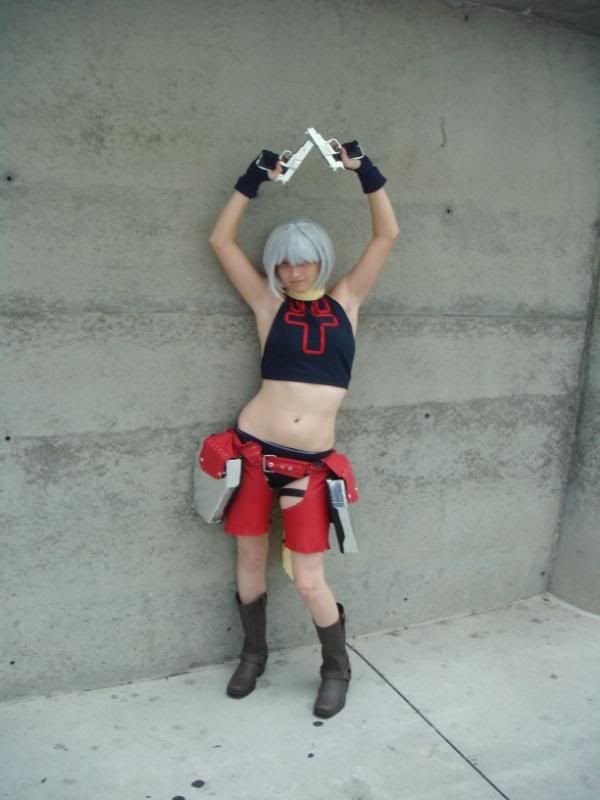
All of these harbingers of doom suggested that AX 2008 would be a deserted, depressed affair, perhaps with tumbleweeds blowing through the convention center in between raids by the marauders of Downtown LA.
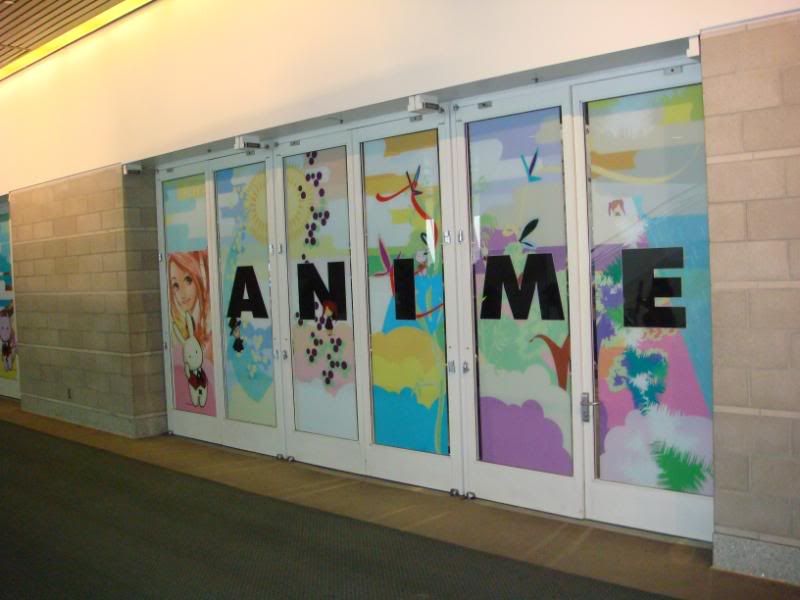
None of that came to pass. Some 43,000 folks attended the con, up 2,000 people from last year. By all accounts, every event went smoothly; the staff performed with aplomb. I haven't heard of anyone who suffered any criminal attacks. And Funimation swooped in like a white knight to rescue the licensed shows orphaned by Geneon's and ADV's problems -- besides announcing popular shows it had licensed itself, such as OURAN HIGH SCHOOL HOST CLUB. (Here's a photo of the English Language cast of that show.)

We had five houseguests staying with us during the con -- Natalie, Christie, LoGan, and Sarah, all from Utah; and Laurid, from Colorado.

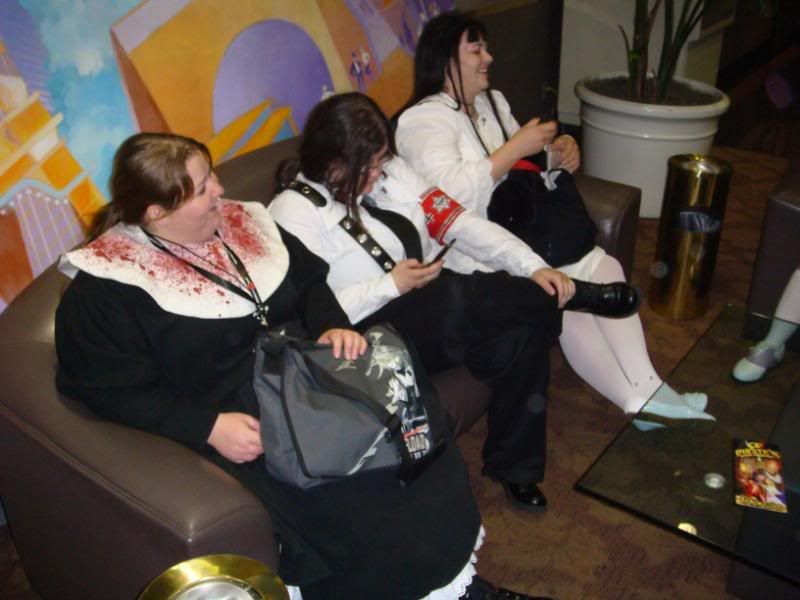
My first day of AX was the con's second day, July 4. We started it out bright and early: The Meet the Guests Reception, traditionally held in the evening, was this time held at 8 a.m. in the morning, complete with continental breakfast buffet. There were a couple of benefits to this: I got to start out the con by meeting the special guests, so that I would not have to go to other events to see them speak; and I got to talk to one of the guests, Japanese voice actor Toshihiko Seki, who would not be able to stay for the entire con. The Meet the Guests Reception is always my favorite part of AX, because it gives the fans a chance to sit down with the guests in a fairly intimate setting and ask them questions one-on-one.
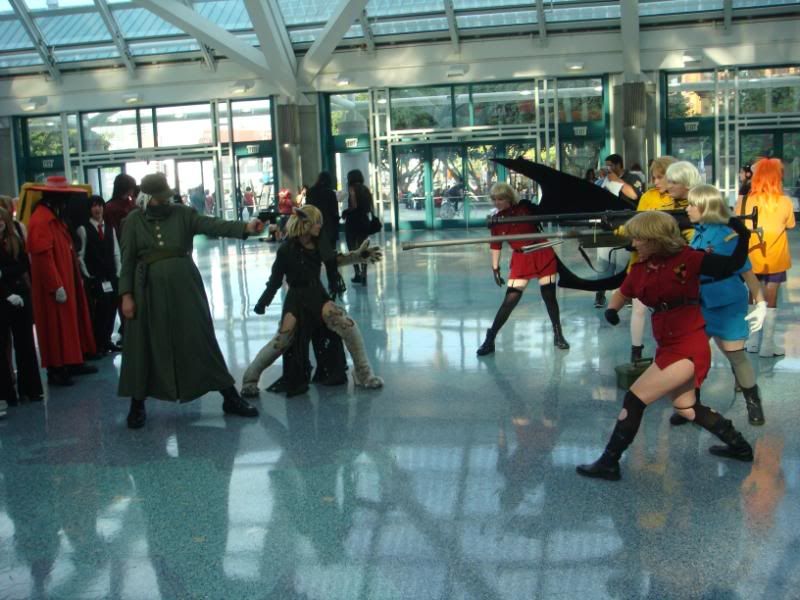
Because all of our houseguests were big fans of the vampire manga and anime HELLSING, and make and wear costumes related to that series, several of our con activities revolved around events related to that show -- including Friday night's unannounced showing of the dubbed Volume IV of HELLSING ULTIMATE (one of the shows temporarily orphaned by Geneon's problems -- but now it's coming out on DVD in September); showings of the first two HELLSING ULTIMATE episodes on Saturday night; and several photo shoots of folks in HELLSING costumes, including the houseguests and Amy.




In short, AX 2008 managed to exceed everyone's expectations -- a rare event for a convention nowadays.
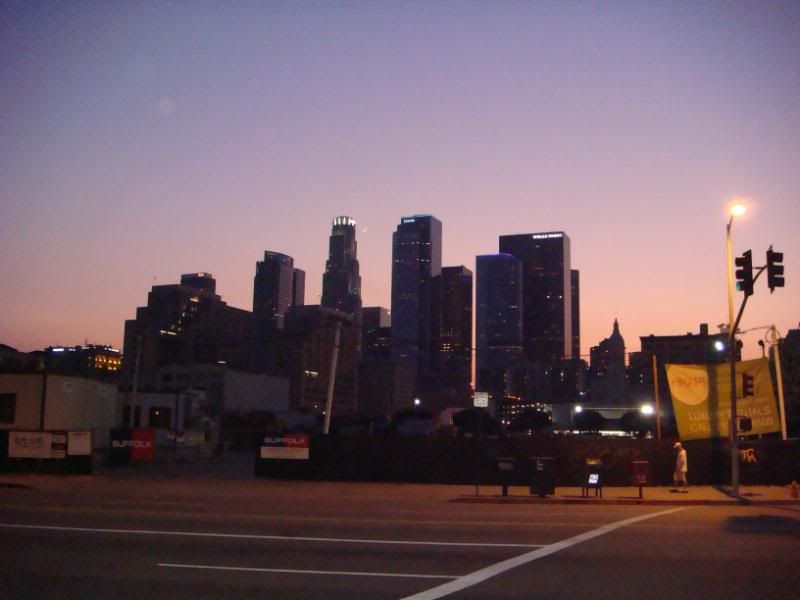
Thursday, July 03, 2008
Go-Go-Go Dancing
To celebrate the release of the live-action SPEED RACER movie in the country of its source material's origin, the English-language Japan Times features this interview with Ippei Kuri, co-creator of the original MAHA GO-GO-GO, a show that never acheived the success in Japan that its American adaptation, SPEED RACER, acheived on the other side of the world.
The insightful interview reveals that the western look of the cars, home, and even appliances in SPEED RACER was inspired by the admiration Kuri had in impoverished post-war Japan for the magical world of prosperity depicted in American films:
"After the war, we didn't have a washing machine, just a board on a bucket. Our living conditions were just awful. When we saw American home-drama films, we saw electric appliances that everyone has now, but that did not exist in Japan at the time. When they opened the refrigerator, there were ready-made ice cubes inside and people are making fancy cocktails. We felt nothing but longing for stuff like that."
Kuri also drew the family unit in SPEED RACER from American films -- one that looked idylic when compared with his loss of his own parents early in his life:
"There would always be a mom and dad who looked extremely happy. There were friends and pets and a good-looking girl next door. All of these things eventually appeared in 'Speed Racer,' and they all came out of my longing for American home life."
Kuri further theorizes that the success of SPEED RACER in America arose out of American nostalgia for such family unity in the late sixties and early seventies, as the American family unit began to drift apart.
The insightful interview reveals that the western look of the cars, home, and even appliances in SPEED RACER was inspired by the admiration Kuri had in impoverished post-war Japan for the magical world of prosperity depicted in American films:
"After the war, we didn't have a washing machine, just a board on a bucket. Our living conditions were just awful. When we saw American home-drama films, we saw electric appliances that everyone has now, but that did not exist in Japan at the time. When they opened the refrigerator, there were ready-made ice cubes inside and people are making fancy cocktails. We felt nothing but longing for stuff like that."
Kuri also drew the family unit in SPEED RACER from American films -- one that looked idylic when compared with his loss of his own parents early in his life:
"There would always be a mom and dad who looked extremely happy. There were friends and pets and a good-looking girl next door. All of these things eventually appeared in 'Speed Racer,' and they all came out of my longing for American home life."
Kuri further theorizes that the success of SPEED RACER in America arose out of American nostalgia for such family unity in the late sixties and early seventies, as the American family unit began to drift apart.
Hellsing -- and Geneon -- Lives Again
I missed the first day of Anime Expo 2008 today because I had to work. But I still heard the most significant industry news announced there: According to the press release linked to above, Geneon USA -- the anime licensing company that effectively croaked last September, placing all of their licenses into limbo -- has entered into a partnership with another licensing company, Funimation. Under the partnership, Funimation will manufacture, market, sell and distribute select Geneon-licensed titles -- most notably Barercave faves HELLSING ULTIMATE,PARADISE KISS, BLACK LAGOON, BLACK LAGOON: SECOND BARRAGE, and KAMICHU.
The last title -- featuring the second season of BLACK LAGOON -- was noteable in that a U.S. cable company, Starz Entertainment, broadcast the dubbed version of the entire season, without editing, even though the DVD rights were in limbo. Imaginasian TV has been doing the same thing with another Geneon series, KYO KARA MAOH! Season two.
The last title -- featuring the second season of BLACK LAGOON -- was noteable in that a U.S. cable company, Starz Entertainment, broadcast the dubbed version of the entire season, without editing, even though the DVD rights were in limbo. Imaginasian TV has been doing the same thing with another Geneon series, KYO KARA MAOH! Season two.
Subscribe to:
Comments (Atom)
